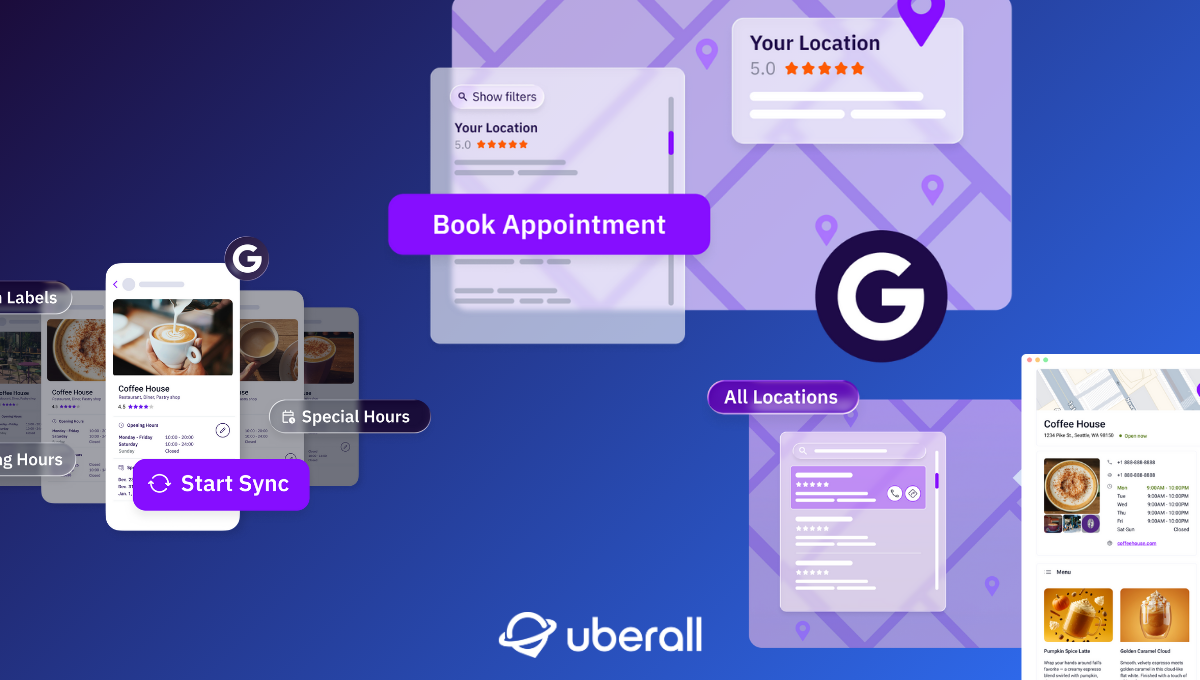
How to Create a Google Business Profile for Services
An effective GBP profile is a vital part of a brand’s online presence, especially for service businesses. Here’s how to maximize your profile’s impact.
The service industry is the backbone of modern economies, contributing around 81% of total economic output in the UK, alongside 78% in the USA, and 70% in France%20across,economic%20sectors%20in%20France%202023&text=In%202023%2C%20services%20contributed%20the,marker%20of%20an%20advanced%20economy.). But in such a saturated market, service businesses must leverage every available tool to stand out.
Beyond creative and innovative marketing, long-term success in this fiercely competitive landscape hinges on getting the fundamentals right. With Google reigning supreme in online search, optimizing your Google Business Profile (GBP) should be a top priority.
Let’s dive into how service businesses can craft a targeted and impactful GBP presence to engage potential customers—though you’re getting the most important insight right away: a one-size-fits-all marketing approach simply won’t cut it, because the service industry—from tattoo parlors and landscape architects to private tutors and accountants—is way too diverse.
Different Types of Service Businesses
Effective businesses should develop their online marketing strategy based on the services they offer and the market they serve. But also, their business model also factors into consideration, since Google’s system distinguishes between three overarching service business models:
- Service-area businesses typically don’t have a physical location open to customers, instead providing services at the customer’s location; like gardeners and plumbers.
- Storefront-based businesses usually provide services from a specific physical location; like tattoo parlors and massage therapists.
- Hybrid service businesses have a physical storefront or office but also provide services at the customer’s location; like private tutors and quantity surveyors.
Each type of service business should adopt a slightly different approach when creating and optimizing their Google Business Profile. Their unique needs influence important details, including keyword research and listing addresses online.
The Unique Local Marketing Needs of Service Businesses
Service businesses have many of the same needs as brick-and-mortar businesses that focus on selling products. However, their online marketing activities entail different challenges and tend to aim for different objectives. Let’s address the obvious difference first: a**service business primarily offers services, not goods**.
A customer’s first encounter with a service business is more likely to occur online, whether the business has a physical storefront or not. With that in mind, making a good first impression today means optimizing the brand’s online presence—including its Google Business Profile.
Also, service businesses target bookings for their services over driving general footfall at their locations. In fact, service-area businesses without a public-facing store or office may not wish to publicize their location at all—a strategic decision diametrically opposed to the marketing objectives of most retail businesses.
Furthermore, as brands without a physical storefront to catch customers’ attention, electronic word of mouth (eWOM) has proven especially important for service businesses. That means cultivating a strong brand presence through active review management and social media.
Finally, service businesses often provide highly targeted services that address specific needs. In many cases, they can also serve a**broader target area** than retail businesses—especially service-area businesses, where specialist employees sometimes travel considerable distances to serve customers.
In sum, this calls for an online marketing strategy that combines pinpoint targeting with a nuanced approach to local search.
GBP Optimization: A Priority for Service Businesses
Given its prominence in search engine result pages (SERPs), their Google Business Profile can represent the closest thing service businesses have to a storefront, reaching their target customer base long before they might otherwise encounter one another.
So alongside your website, you should consider your GBP a cornerstone of your online presence and a critical tool for boosting your online visibility. Why? Because a solid GBP provides information and customer reviews in an established format familiar to customers.
What’s more, it signals credibility: customers are 2.7x more likely to regard a business as reputable if their Google Business Profile is complete.
How to Optimize Your GBP: 4 Tactics for Service Businesses
Google Business Profile allows you to control how your service business appears across the entire Google platform, from Search to Maps to Shopping—so you better start optimizing.
1. Add Relevant Info
Start building your profile with content and information specifically geared towards boosting your visibility in local search results; like your name and your phone number. Then move forward to categories, attributes, and local keywords.
- Google categories are being used by Google to understand your business and display it as a result for relevant searches. You can select one primary category and several secondary categories that concisely describe the services you offer.
- Google attributes allow you to provide more granular insights into your services. Choosing suitable attributes enhances your brand’s visibility in search results and allows customers to build a more detailed picture of what they can expect from you.
- Local keywords embedded in description, categories, and attributes allow you to home in on your target audience; especially long-tail keywords with geographic modifiers such as “Italian restaurant in New York City” or “landscape gardener in Glasgow”.
And lastly, add—if you can—photos of your services as well as social proof; namely reviews.
2. Mark Your Service Area
Accurately defining the service area is an elementary step in GBP optimization, especially for service-area and hybrid businesses. And while service businesses with a fixed storefront or office should make sure to enter their address as well as their service area, those without a physical location open to customers should only enter their service area.
You can edit your service area in your settings in either Google Search or Google Maps. Enter a postal code or district name to define a service area, and a polygon will appear on the map to display your chosen area. This allows you to set up to 20 service areas in your GBP settings.
You should also consult Google’s recommendations for defining service areas, which include setting boundaries no more than two hours’ drive from your base of operations. Getting this right is crucial, as Google’s algorithms take account of your service area when determining your relevance to local search queries. And, of course, defining your service area correctly can boost your reach among customers in those zones.
3. Embrace Proactive Review Management
Online reviews serve as a powerful trust signal—for potential customers looking to independent reviews for reassurance, and for search engines that regard positive reviews (and active review management) as a sign of credibility and authority.
But also, reviews represent an invaluable source of objective feedback on your services, enabling you to identify best practice and areas in need of improvement while engaging directly.
Google’s platform reigns as the centerpiece of a brand’s online reputation: an investigation by ReviewTrackers found that Google hosts 73% of all online business reviews. Another recent BrightLocal survey confirmed Google’s position as the most popular online review platform, used by 83% of respondents seeking testimonials on local businesses.
In other words, claim your Google Business Profile and actively respond to reviews if you want to control your brand’s online reputation.
4. Integrate with Other Platforms
So, you’ve crafted a compelling Google Business Profile, selected relevant categories and attributes, defined an accurate service area, and implemented an effective review management plan. After checking off the fundamentals, you should look to maximize your online impact by integrating other services, channels, and tools with your GBP.
Within Google’s services, you could consider linking Google Ads to extend your reach through targeted campaigns, or Google Analytics for detailed insights into your marketing performance. Reserve with Google also links with various booking providers, allowing your customers to book your services directly on the search results page.
You should also consider integrating your social media accounts into your Google Business Profile. This way, you can cross-post while supplementing your profile with engaging media, such as high-resolution photos and high-quality videos.
Linking your profiles across different channels conveys competence and confidence by forging a cohesive online presence that features consistent messaging.
Consistently Up-to-Date Listings – Across the Board
Service businesses looking to curate an effective online presence should make optimizing their Google Business Profile a priority. That said, any ambitious company targeting sustained success should cast their net more widely.
Claiming and maintaining listings in numerous directories allows you to engage the widest possible audience. Don’t underestimate the power of sector-specific local directories, either—such as RateMDs for medical professionals or HomeAdvisor for carpenters, cleaners, and moving companies.
We cannot stress this enough: the key lies in keeping all your listings across every site fully up to date with accurate information about your business. However, if you expand from Google Business Profile to a dozen other business listings, the workload of managing their content can soon become a job in itself!
The answer? An integrated, automated software solution like Uberall Listings to create, manage, and optimize listings from a single, intuitive interface—with an extensive network, which brings together 125+ business directories.
Best Practices for Service Google Business Profiles
RE/MAX Europe, a leading real estate network, centralized the management of their location data and customer reviews across multiple countries using Uberall's platform. This approach allowed them to standardize their online presence, ensuring that each franchise location—which normally makes it all the more complicated—had accurate and consistent information, thereby enhancing their visibility in local searches.
Similarly, Tempton Group, a personnel services provider with over 200 branch offices in Germany, partnered with Uberall to achieve centralized management of their online presence. By ensuring 100% completion of their GBP listings and maintaining consistent NAP information across all directories, they improved their online visibility and saw significant increases in engagement metrics, such as clicks to call and directions.
Looking to refine your online presence? Book a demo to explore the Uberall platform’s powerful functionalities.
Ready to Transform Your Business?
Connect with our partnership team to learn how Uberall can help you achieve similar results. Get a personalized consultation and discover the opportunities waiting for your business.
Resources











